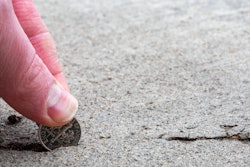
Plastic shrinkage cracking is commonly associated with hot weather concreting, but it can also occur when the surface concrete dries and shrinks because of rapid moisture loss.
As the name implies, this form of cracking occurs when the concrete is still plastic and is caused by shrinkage due to rapid moisture loss. Plastic shrinkage cracks appear in the first few hours after concrete placement and typically before the finishing operations are complete. Seen primarily in exterior concrete slabs, these cracks also can sometimes occur in steel-troweled floors when the moisture loss is severe and final curing is delayed.
Understanding the causes, monitoring jobsite conditions and implementing precautionary measures can minimize these unsightly cracks.
Influencing Factors
Surface cracking can occur when surface moisture of recently placed concrete evaporates faster than it can be replaced by the rising bleed water, causing the surface concrete to shrink more than the interior concrete. Because the interior concrete restrains the shrinkage of the surface concrete, tensile stresses form on the surface. When these stresses exceed the tensile capacity of the plastic concrete, surface cracking occurs. Cracks start on the surface and grow downward creating V-shaped cracks as illustrated in Figure 1. Cracks grow deeper with increasing rates of moisture loss.  Figure 1. When the surface evaporation exceeds the bleed rate, the top surface dries and shrinks. If the shrinking auses the tensile stresses to exceed the tensile capacity of the plastic concrete, surface cracking occurs.
Figure 1. When the surface evaporation exceeds the bleed rate, the top surface dries and shrinks. If the shrinking auses the tensile stresses to exceed the tensile capacity of the plastic concrete, surface cracking occurs.
Rapid moisture loss and drying of the surface have traditionally been blamed for the occurrence of plastic shrinkage cracking. However, any factor that increases the rate of moisture loss from the surface, reduces the amount of bleed water rising to the surface or delays hardening of the concrete, increases the risk of cracking. Influencing factors include:
- Ambient jobsite conditions during concrete placement and finishing;
- Mixture proportions;
- Type and content of Portland cement and supplementary cementitious materials (fly ash, silica fume, etc.);
- Water-cementitious materials ratio; and
- Type and dosage rate of chemical admixtures and temperature of the fresh concrete.
Even construction operations including screeding and finishing operations may influence the risk of plastic shrinkage cracking (Ref. 1).
In fact, the risk of plastic shrinkage cracking depends on many factors, not solely on the rate of moisture loss or rate of evaporation from the surface. However, most project specifications rely on limiting the rate of evaporation from the surface as the primary means of controlling plastic shrinkage cracking (Ref. 2 & 3).
The default maximum allowable rate of evaporation commonly used is 0.2 lb/ft2/h. However, ACI 305.1-14 Specifications for Hot Weather Concreting recommends reducing the maximum allowable rate of evaporation to lower values when the concrete mixture contains conventional or ultra-fine pozzolans or other cementitious materials that may reduce the rate of bleeding and delay concrete hardening. For these type of mixtures, 0.15, 0.10 or 0.05 lb/ft2/h limits are more appropriate.
Monitoring the Risks
By using the nomograph, the rate of evaporation of surface moisture—or more specifically the severity of the evaporative exposure and risk of plastic shrinkage cracking—can be estimated from the measured air and concrete temperatures, relative humidity of the air and wind velocity above the surface of the concrete.
To properly use the nomograph, measure and calculate the average horizontal wind speed at 20 in. above the concrete surface, measure the air temperature and relative humidity at a level approximately 4 to 6 ft. above the concrete surface on the windward side and shielded from the sun’s rays. The concrete temperature is the temperature of the freshly placed concrete. Begin monitoring one hour before the start of concrete placement and continue at 30-minute intervals or less until the final curing procedure has been applied.
Instead of measuring the individual input values and using the nomograph, many contractors are using portable, jobsite environmental meters especially designed to automatically compute evaporation rates from concrete. Meters provide an easy and convenient way to track the plastic shrinkage potential.
Controlling Plastic Shrinkage Cracking
There are several preventative measures to control surface evaporation, which include:
- Erecting temporary windbreaks and sunshades (if practical);
- Applying a sprayable evaporation retardant;
- Covering the flatwork with plastic sheeting between finishing passes; and
- Fog spraying the flatwork.
Other preventative measures include dampening the base material before placing concrete, lowering the concrete temperature by using chilled water or chipped ice, including microfibers in the concrete mixture to increase the tensile capacity of the plastic concrete, protecting the concrete from evaporation during construction delays, and applying the final cure as soon as possible after finishing/texturing.
Evaporation retardants are moisture-retaining films that reduce the rate of evaporation from the surface of the concrete between the various finishing operations. Because most of these products after mixing consist of one-part retardant and nine parts water, they should not be used as a finishing aid or worked into the top surface of the concrete. Mixing water into the top surface can reduce concrete strength, durability, and abrasion and scale resistance. Environmental meters provide an easy way to estimate the rate of evaporation. The user enters the concrete temperature and the instrument measures the air temperature, relative humidly and wind velocity and calculates the rate of evaporation.
Environmental meters provide an easy way to estimate the rate of evaporation. The user enters the concrete temperature and the instrument measures the air temperature, relative humidly and wind velocity and calculates the rate of evaporation.
Fog spraying increases the relative humidity in the air above the concrete, which reduces the rate of evaporation from the surface. Fogging can also help replace the bleed water that prematurely evaporated from the surface. Accumulated surface water from fogging should not be worked into the top surface of the concrete. Fog nozzles should create a blanket of fog, not a water spray that can wash away the surface of the concrete. Locate the water sprayer upwind of the concrete, and discharge the spray into the air above the concrete. Pressure washers with a fine spray nozzle can be easily used to fog flatwork for small- and medium-sized jobs.
Plastic shrinkage cracks are usually superficial and seldom repaired. However, they may create aesthetic concerns, especially for decorative concrete. Depending on the cracking severity, crack width and depth, and the concrete’s exposure conditions, plastic shrinkage cracks may create durability concerns. The potential for reinforcement corrosion and concrete freeze/thaw damage, for example, may increase if water and de-icing chemicals enter the concrete through plastic shrinkage cracks.
The best way to avoid aesthetic and durability concerns related to plastic shrinkage cracks is to understand the susceptibility of a concrete mixture to cracking, monitor the jobsite conditions and take the necessary actions to minimize rapid moisture loss from the surface of the concrete.
Kim Basham is president of KB Engineering LLC, which provides engineering and scientific services to the concrete industry. Basham also teaches seminars and workshops dealing with all aspects of concrete technology, construction and troubleshooting. He can be reached via e-mail at [email protected].
References
- Shaeles, C. A. and Hover, K. C., Influence of Mix Proportions and Construction Operations on Plastic Shrinkage Cracking in Thin Slabs, ACI Materials Journal, No. 85-M48, November-December 1988, American Concrete Institute, www.concrete.org
- ACI 305R-10 Guide to Hot Weather Concreting, American Concrete Institute, www.concrete.org
- ACI 305.1-14 Specification for Hot Weather Concreting, American Concrete Institute, www.concrete.org
- Kosmatka, S. H. and Wilson, M. L., Design and Control of Concrete Mixtures, 15th Edition, 2011, www.cement.org



















